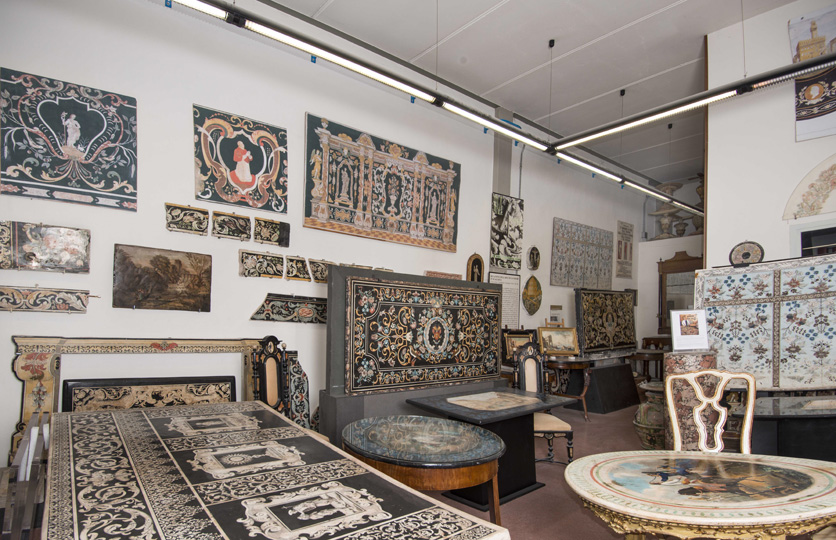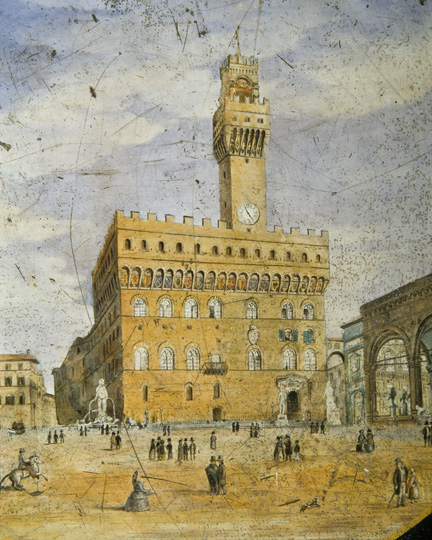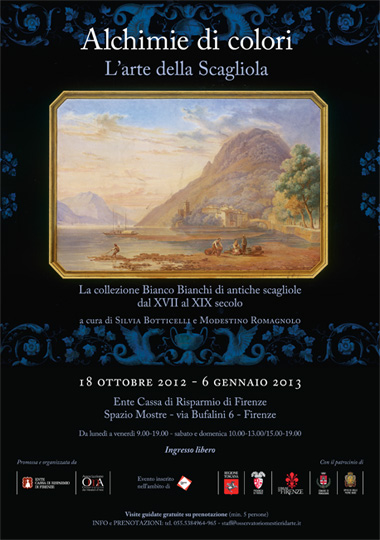Bianco BianchiTHE COLLECTION |
Scagliola is a particular inlay work technique that uses natural materials such as selenite dust, colored pigments and natural glue wich are mixed together (hence the name meschia). Scagliola is also a mineral stone (selenite) that at the natural condition presents itself as lamellae.
Certain phiscal qualities of the scagliola, like its shine, transparency and pearly brilliance have inspired the creation of new labels: crystal chalk, ass's looking glass, mirror stone, oil glass, stone of the moon. Known since ancient times (the Romans used slabs of mirror stone for the walls of the Circus Maximus to obtain a pleasant witheness) and utilized as a building and decorative material, the use of this technique became a true artistic expression in the XVII century.
At first it was used to imitate the veins in marble and marquetry. Then, for its enormous ductility, the use of scagliola became a decorative technique, able to unite various artistic techniques among which paintings (pictures and panels with views and landscapes), incision (two-colors or sanguine) and the plastic scagliola for mantelpiece and altar-piece in relief.
The historical news agree to notice a contemporaneity in the use of colored scagliola at the end of XVI century and early XVII century in Germany and Italy. Anyway we can affirm that Carpi in Emilia was the greater place of diffusion of this techinque in XVII century, with the creation of black and white works first, then of polycrome works for ecclesiastic clients.
In the XVII century Florence and Tuscany scaled the full recognition of scagliola thanks to Enrico Hughford (1695-1771) monk who lived at the Monastery of Vallombrosa.
Works of scagliola can be admired in Florence, in Uffizi Museum, Pitti palace, Opificio delle Pietre Dure, in the church S.Miniato al Monte (reconstruction of some columns dated XIX century), in Oratorio di San Tommaso d'Aquino (wall covering). On the surroundings of Florence works of scagliola can be admired in Settignano, Chianti, Valdarno, Valdisieve and the Monastery of Vallombrosa with Monk Hughford's works; then at the Victoria and Albert Museum in London, at the Louvre in Paris, Hermitage Museum in Saint Petersburg and in many museums and private collections in USA and Europe.
In the XIX century the institution of a chair in the Academy in Florence and the work of Della Valle brothers in Leghorn were the last expression of this technique.
Then, Bianco Bianchi (1920-2006) found it out again around on 1950. To learn the techinque and the materials used in the past, Bianco Bianchi collected ancient works (also may fragments) of different age and origin. With his passion he made the most complete existing collection.
Today his workshop deals all along to the restoration of antique scagliola, too.
In 1997 the Poligrafico dello Stato published a book “Scagliola. L'arte della pietra di luna” Anna Maria Massinelli – Editalia – Roma. This book attached importance to this collection.
The collection has been included in the “Guide Rosse Touring Club” and in the catalogue of Musei dell'Artigianato Italiani.
The recent exhibitions praise to the passion and obstinacy of Bianco Bianchi and his children Alessandro and Elisabetta continue the family tradition.
The last exhibitions:
2002 in Paris - “Firenze e la Toscana a la Gare de Bercy Paris”
-
2005 in Greve in Chianti - “I colori della pietra di luna”
-
2006 Levante Fiorentino - “Scagliola inganno sublime”
-
2010 in Pavia – Castello di Belgioioso - “Le scagliole della collezione Bianco Bianchi”
-
2010 in Avellino - “Perle Barocche. La collezione Bianchi”
-
2013 in Florence - “Alchimie di colori”
Reminding the publications in addition to the above mentioned:
-
“Il fascino dell'illusione” - Silvia Botticelli – Ed. Edifir Firenze 2006
-
“Alchimie di colori, l'arte della scagliola” - Silvia Botticelli – Ed. Polistampa Firenze 2012



















